Post-War Britain And The Nuclear Age In Cinema
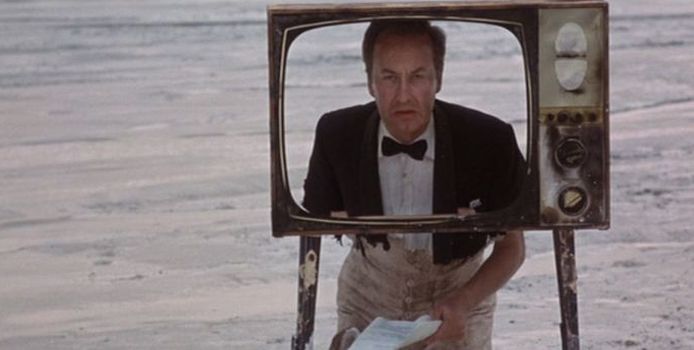
Massive film lover. Whether it's classic, contemporary, foreign, domestic, art,…
One of the more curious cultural changes in the post-war era was the cinematic climate that permeated in the United Kingdom in the years following WWII. These movies vary from paranoid thrillers, atomic-age science fiction and docudrama’s that veer on a level of horror due their level of accuracy regarding the terrifying nature of nuclear war.
The feature films that came out in this period are terrifying on varying levels; one of those being the self-reflective element that is so common in movies and that reflection was cast by the looming possibility of WWIII. This era in British cinema is crucial because The Cold War was one of the first global conflict that was heavily televised, but for all the years it staggered on it never turned hot. This purgatorial effect was enough to stoke the coals for a hot-bed of filmic theorizing regarding the British identity and how it would sustain (or survive) mass destruction.
Bear in mind the timeline for The Cold War ranges from 1947 to the falling of The Berlin Wall in 1990, that is a wide breadth of time. During this time British cinema expanded its cinematic imagination utitlizing propaganda, B movie genre pieces, animation and documentaries.
Nuclear War in Every Home – “Protect and Survive”
During the years after WWII Britain (like many other nations at the time) became embroiled in the paranoia that fueled The Cold War. Due to its location, geography and national relations following (NATO) turned the UK into a hotbed of Cold War hysteria. Once military intelligence in concert with the Civil Defense Corps calculated the ruination that would follow in the wake of a nuclear attack, a media campaign was launched, educating people how to “survive” an attack. Civil Defense released a series of pamphlets: “Fallout Protection”, “Survival Under Atomic Attack”, and the laughable “Duck and Cover” campaign.
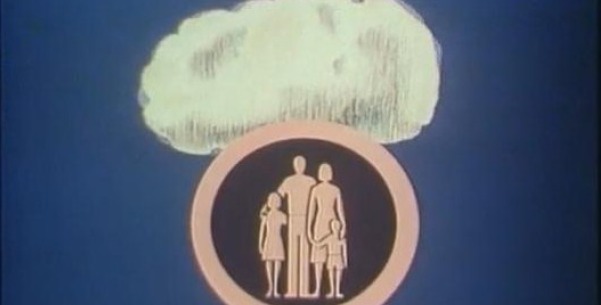
The British government also launched a public information initiative called “Protect and Survive”; their media ranged from literature, radio announcements, and the most chilling PSA’s (Public Service Announcements) that were in consistent rotation instructed the public on how to build a core shelter in your home, building sandbags, how to identify different air raid sirens, life in fallout conditions, and how to dispose of dead bodies. The alarming nature of these PSA’s installed fear in the minds of the public, as they were constantly bombarded with reminders as to how to handle the actual horrors of nuclear attack.
https://www.youtube.com/watch?v=hGMdnod8VPIWhat’s more alarming, the content, or the threat being so eminent that the content is necessary?
The Cold War and its Role in Britain’s Movies
The following films are important because they come from a time and a place that is so specific and distinctive that there is absolutely no way they could be replicated or imitated. The Cold War left its mark on nations across the world, but the story of Britain’s cinema during this time is most unique. Unlike the gung-ho WWII patriotism that permeated screens in the forties, with movies like In Which we Serve or the Why We Fight Series. The difference with WWII and The Cold War is that the later was Cold (meaning no active combat) resulting in a myriad of creative diversity. Instead of recreating The Battle of Iwo Jima, writers and directors channeled their fear and anxieties through other genres like science fiction, or satire.
Unlike American movies about the Cold War, which seem to distance us from the pending damage of an attack, films like Fail-Safe, and Dr. Strangelove are indeed classics, but they’re at a remove, and we as viewers may feel involved, but that lack of reference (taking place in military bunkers) makes us feel slightly alienated from the action at hand. Fail-Safe is a classic indeed, but even the sanitized image below makes it seem a little too safe (no pun intended) to properly convey the urgency of nuclear war.
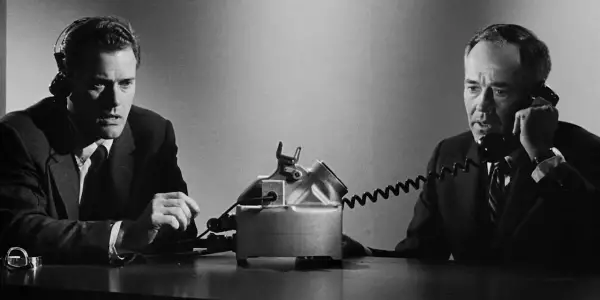
With other movies from Britain through the sixties and eighties like The War Game, and Threads filmmakers couldn’t turn their camera’s to capture what was, instead they had visions of what could be. Which are a striking contrast to the American war movies.
Science Fiction Portrayed as Science Fact – The Quatermass Xperiment
With a full-fledged media campaign during the Cold War, PSA’s were in heavy rotation and a constant reminder coming through the television and radio.
Of course, art is influenced by real life, and it was an inevitability that the climate of nuclear paranoia would influence TV and movies. The Quatermass Experiment (1953) started as a BBC serial, Nigel Kneale’s script was rapidly appropriated by Hammer Studios and their 1955 feature film The Quatermass Xperiment (1955) (the “E” was dropped in order to emphasize the films X-rating) was a major hit for the studio.
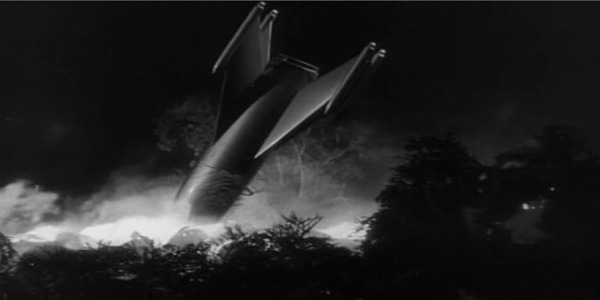
Drawing on themes of postwar paranoia (in the BBC series and Quatermass and the Pit (1967), an alien craft is mistaken for a stray bomb from WWII) and invasive hostile forces took the shape of alien intruders but the political implications are present.
Another type of Sci-Fi from Hammer – These are the Damned
Another stand-out title from Hammer Studios line of sci-fi entries is Joseph Losey’s The Damned aka These are the Damned (1963). An odd mixture of street gangsters and science fiction These are the Damned was shot in 1961 and shelved for two years until it was released to mixed critical reactions.
After their success with their gothic horror films (The Curse of Frankenstein, Horror of Dracula, and The Mummy) These are the Damned was a hard film to advertise then and still not the easiest sell these days but it’s a gem of its time for those who like distinctive cult items. The film starts off like any routine “youth gone wild” story that gradually mutates into a cautionary science fiction tale once the story steers its way into a bunker filled with genetically designed to withstand and survive a nuclear attack.
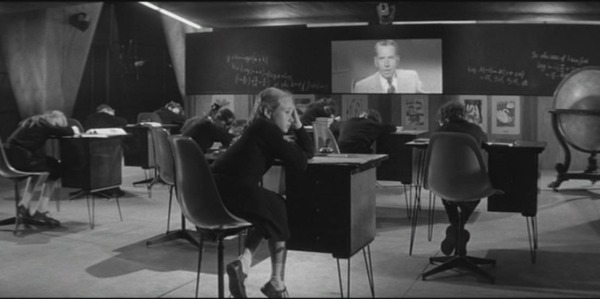
Of course, in order to withstand nuclear radiation the children are irradiated to such a high level that any prolonged exposure to them will kill whoever comes in close contact. They are, (or were) in a sense the future of what Britain would have if they had fallen victim to a nuclear attack. These are the Damned is a strange entry in Hammers chronology. At this point in time the word “Hammer” conjured images of lurid, Gothic era Frankenstein and Dracula remakes, These are the Damned is hard science fiction in a modern setting, opposed to the Victorian era chillers that made the studio famous.
Val Guest adopted documentary style for the look of the movie, and the script is tight. Unlike the other atomic-age science fiction projects ( Them!, Tarantula, The Blob) The Quatermass series excelled past the level of “good sci-fi” but proved that the genre could intelligent and mature.
Too close to home – The War Game
A one of a kind documentary, The War Game is a fascinating oddity as it is a combination of instructional documentary, and staged docudrama. Originally conceived as a government mandate in order to “educate” people by recreating the events that would occur in the events leading up to, during, and after a nuclear attack on Britain.
The events depicted in the film are horrifying. It opens with a frighteningly stark narration and statistics about Britain’s location as a Soviet missile target. While watching the film, it’s hard to believe this was a government supported project as it feels like the opposite of a propaganda movie. One would expect a government endorsed docudrama would entail a forged chronicle, attempting to ease the public’s anxieties, when in fact The War Game does the exact opposite.
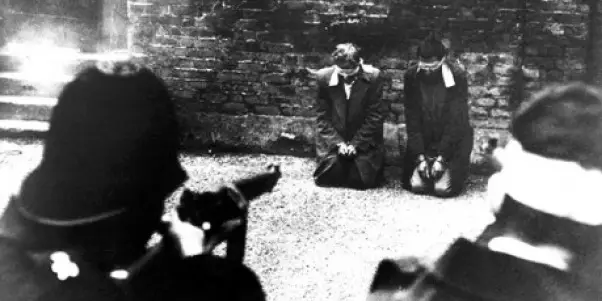
Peter Watkins’ The War Game recreates the excruciating details of a potential nuclear attack on Britain. Watkins explicitly portrays people rioting, houses consumed in flames, children with 2nd and 3rd-degree burns, mass starvation, martial law, civilian violence and the deadly conditions of nuclear fallout. Most chilling is the brutally realistic depiction of over burdened hospitals that have to resort in executing patients beyond recovery by shooting them in the streets. This macabre treatment might seem overbearing, however The War Game captures Britain’s (predicted) administrative inability to manage the conditions following a nuclear attack. One would expect a government-endorsed docudrama would entail a forged chronicle, attempting to ease the public’s anxieties, when in fact The War Game does the exact opposite.
Originally conceived for provisional viewing by the BBC, controversy erupted once The War Game was first screened. Defense ministers condemned it for its anti-war tone, while members of the media and press demanded that the film be shown. The BBC continues to deny that they banned Watkins film because of legislative pressure, but these allegations are unconfirmed due to the nature of the BBC’s secret screenings; while it was banned, the BBC held private screenings of The War Game to senior members of the Home Office, Ministry of Defense and representatives of The Military Chiefs of Staff.
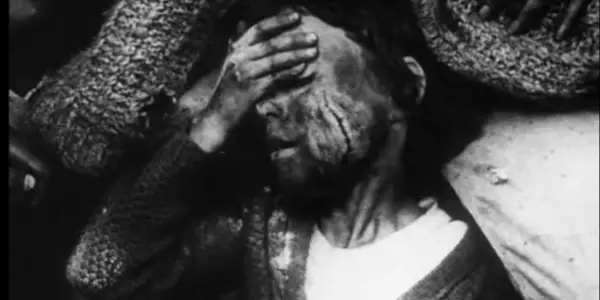
The film went largely unseen in the UK (although it won the Academy Award for Best Documentary Feature in 1967), until it was publicly screened July 31, 1985 for the fortieth anniversary of the Hiroshima bombing.
Peter Watkins’ film may only have a running time of 48 minutes, but it doesn’t spare its viewer one moment of respite from the unrelentingly shocking material recreated. Based on the source material from the bombings in Hamburg, Hiroshima, and Nagasaki, and done in coordination with medical personnel, The War Game is still a frightening historical record.
Chilling Animation – When the Wind Blows
When the Wind Blows is a daring animated feature that uses a minimal cast to explore how the nuclear paranoia of the Cold War can effect the WWII generation (or “Greatest Generation”) and the way their beliefs and values contrast with the younger, “modern” culture. The film is a heart breaking tale of an elderly couple, Jim and Hilda Bloggs, (voice work done by Peggy Ashcroft and John Mills) whose memories of WWII reinforce their confidence in trusting military aid.
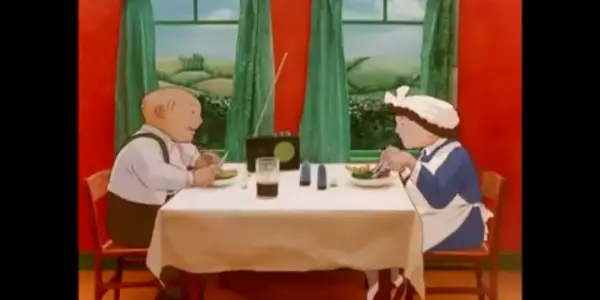
Written by the author of the graphic novels by the same name, Raymond Briggs, and directed by Jimmy Murakami, When the Wind Blows is a well structured, yet deceptively simple tale of blind faith regarding the ever changing military complex. There are many elements that make When the Wind Blows so poignant is its experimental flourishes, while the austere tone of the film is sustained from start to finish. In some scenes the characters dreamily exaggerated recollections of WWII fill the screen, meanwhile Jim and Hilda Bloggs’ gradual disintegration is hauntingly realistic.
Armed with a unique sense of animation where hand drawn characters interact with what looks like cutouts of real objects and the hallucinatory soundtrack by Roger Waters supplement both the dreamlike aspects of escapism that is so much a part of the characters own perception that it is contagious to the viewer. All the while the driving heart of the films message directs the viewer back to the nightmarish realism that ensues.
A reference that sticks out are the references to the Protect and Survive public information films and pamphlets that had populated Britain at this time; for instance, the shelter the couple build are identical to those in the Protect and Survive.
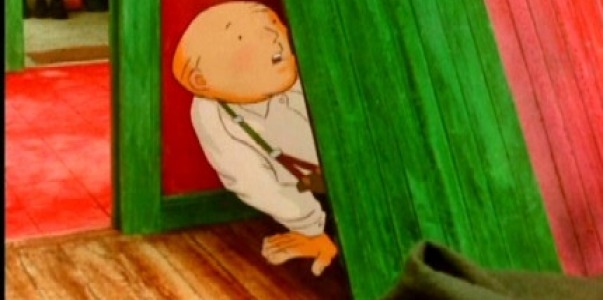
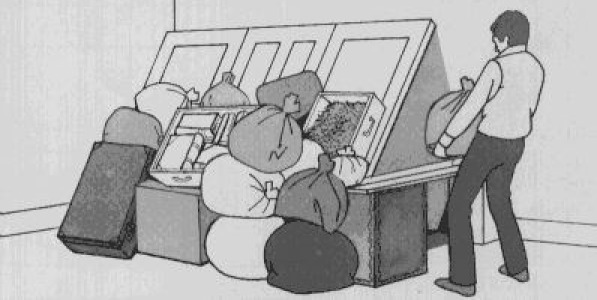
The film is animated with style and the story moves at a decent pace given the simplistic nature of the film. The result might be a bit dour, when dealing with nuclear war don’t expect an upbeat finale. It’s equally chilling and sad, as well as a telling indictment of the active government at the time.
Nuclear Satire – The Bed-Sitting Room
Who says that nuclear disaster films can’t be funny? Stanley Kubrick may have been the first to break the mold of straight-laced war movie, but Richard Lester took Cold War satire to another level with his 1969 film The Bed-Sitting Room.
The Bed-Sitting Room features a great cast of the finest talent England has to offer: Ralph Richardson, Rita Tushingham, Dudley Moore, Peter Cook, and Michael Hordern, who are all in top form. The movie is the type of film that could have only been made in the late sixties, and it takes on the government, the church, the media, and well, everything. The plot is from the play of the same name by Spike Milligan, and revolves around the twenty-something survivors of Britain after it is destroyed in an (as one character calls it) “nuclear misunderstanding.”
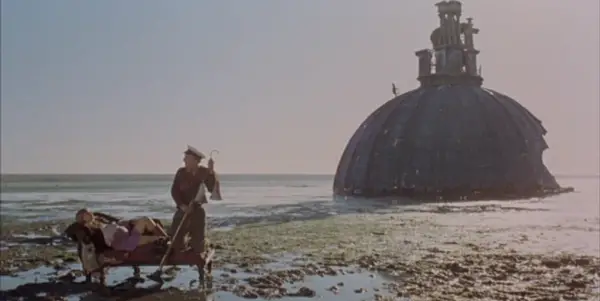
After our civilization is destroyed, a clan of various individuals who made the ruins their home after the war. Some hang around others ride the underground train; a former BBC reporter recreates newscasts behind a broken television frame, but for the most part they have their own little society among the rubble. Oh, and people are slowly changing into parrots, and furniture, in one special case a bed-sitting room, hence the title. The Bed-Sitting Room takes all aspects of nuclear devastation under satiric scrutiny, even the idea of death and mutation.
The comedy in the film is ironic, physical, absurd, satirical and, above all, funny.
Once the Sixties Passed, Matters Became Less Funny and More Serious – Threads
By the 1980’s England was in a dire financial crisis, and the country was immersed in a deep recession. Thanks to Margeret Thatcher’s campaign to decrease inflation, and her monetarist policies, the rate of unemployment in 1983 was up to three million, the highest it had been in fifty years. The BBC production Threads feels like a narrative realization of Peter Watkins’ docudrama The War Game, nineteen years earlier. Mick Jackson directs Barry Hines’ rugged script with all the boldness that such a potent subject deserves.
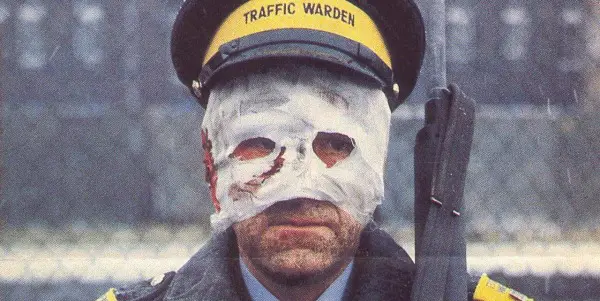
Threads ties its narrative of nuclear devastation to the romance of two young lovers from Sheffield (Ruth and Jimmy), who decide to marry. Meanwhile, tensions mount between the U.S. and the Soviets over hostilities in Iran. After the Soviets ignore an ultimatum from the U.S., WWIII is ignited, and pandemonium erupts throughout the United Kingdom. The preceding action takes its time (effectively) with character development, scrolling title cards informing the viewer of nuclear escalations, food distribution, dates and times, chronicling the aftermath of the attack.
Building the mounting tension the filmmakers slyly incorporated the dreaded “Protect and Survive” PSA’s into the background of the movie as the characters go about their business. This implied aura of anxiety is intelligently implemented by using the actual “Protect and Survive” PSA’s and not an imitated recording.
Threads goes beyond the tradition of narrative filmmaking, spanning years beyond the attack as civilization tries to rebuild itself. This extra step counters the standard rhetoric of common narrative structure not in a rebellious way but as a means to deliver an important message without being obvious or preachy. Threads is an unflinching look at life before, during, and long after a nuclear war. With images that are far more terrifying than anything you could find in any horror movie. Threads may have been made for TV, but it’s a BAFTA award winning film and it’s powerful as a historical document and an important piece of British cinema.
Conclusion
While movies like Threads and When the Wind Blows contrast in style and tone, they both share a powerful and tangible quality that bring the viewer to face to face with nuclear devastation. It seems that British films after WWII were more concerned with realism than escapist entertainment. While Hammer Studios took their sci-fi films such as The Quatermss Xperiment, and These are the Damned and infused them with maturity and paranoid terror. All of these titles couldn’t differ from each otherh
Is there such a contrast between The Cold War films that came out in Britain than those from the United States? Is it a result of Britain’s involvement in The Cold War that made such a profound impact on its film industry?
(top image: The Bed-Sitting Room (1969) – source: United Artists)
Does content like this matter to you?
Become a Member and support film journalism. Unlock access to all of Film Inquiry`s great articles. Join a community of like-minded readers who are passionate about cinema - get access to our private members Network, give back to independent filmmakers, and more.
Massive film lover. Whether it's classic, contemporary, foreign, domestic, art, or entertainment; movies of every kind have something to say. And there is something to say about every movie.













